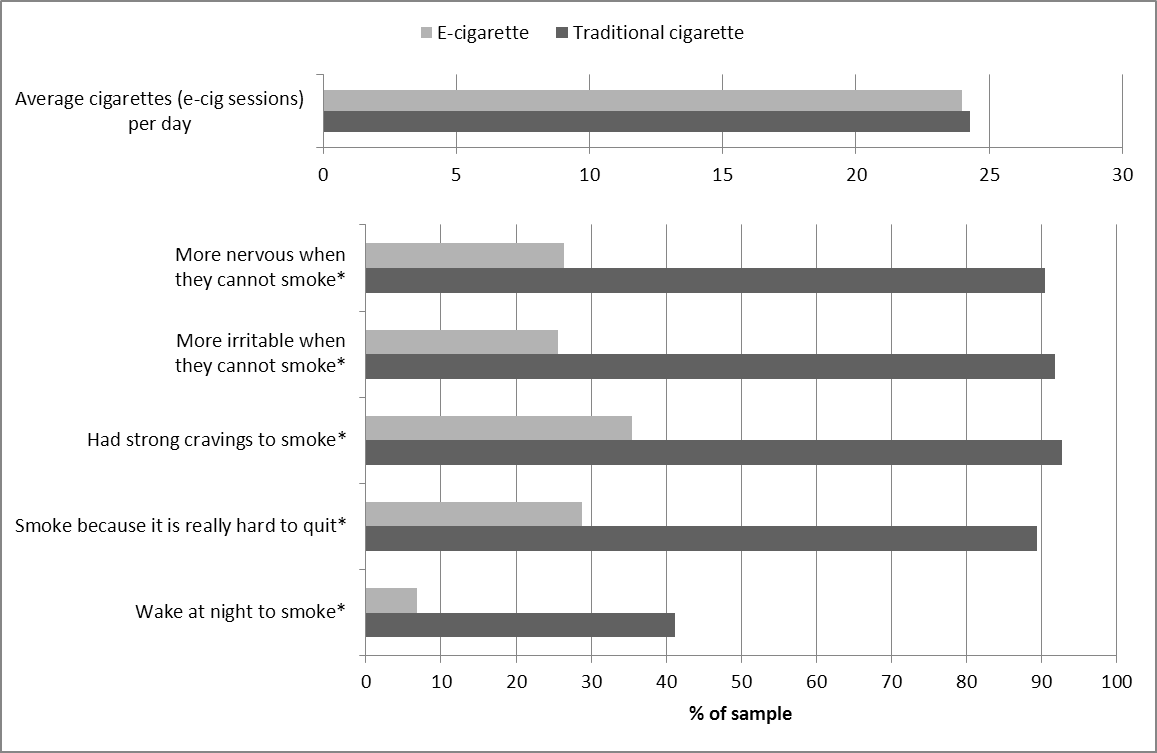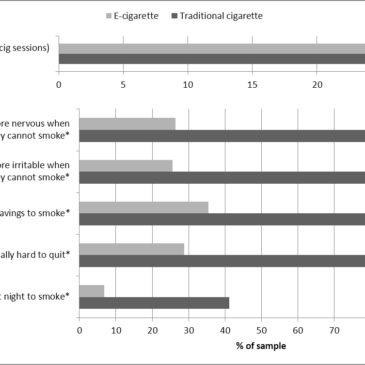Many people use e-cigarettes because they view them as a relatively healthy alternative to cigarettes (Chapman & Wu, 2014). Previously, we have described e-cigarette use patterns (ASHES 10(3)) and associated health changes (ASHES 11(7)). However, it is unclear whether e-cigarettes have the potential to create physical or psychological dependence to the same extent as cigarettes. This week, we review a study that compared smoking behavior and dependence potential for cigarettes and e-cigarettes (Foulds et al., 2014).
Methods
- The researchers developed a 10-item questionnaire (The Penn State Electronic Cigarette Dependence Index) to assess participants’ use of, and dependency on, both cigarettes and e-cigarettes. Each of the 10 items assessed an aspect of dependency (e.g., having strong cravings, feeling irritable when not smoking/vaping). The researchers created an Index score across items, with a possible range of 0 (not dependent) to 20 (highly dependent).
- The researchers recruited e-cigarette users from a variety of websites to complete an online survey on e-cigarette use and its role in replacing other types of tobacco use. A total of 6,745 people provided complete data.
- The researchers restricted the final sample to current e-cigarette users who were ex-cigarette smokers (n = 3,609, 54% of the total sample). On average, they had been using e-cigarettes for just over 13 months.
- Participants described their current use of, and dependence on, e-cigarettes using the index described above. They were asked to recall their experiences of smoking along the same dimensions.
- The researchers examined whether participants’ current dependence on e-cigarettes was comparable to their recollections of being dependent on cigarettes.
Results
- E-cigarette users vaped at the same frequency as they had smoked in the past (Figure 1).
- However, paired t-tests revealed that e-cigarette users had significantly lower E-Cigarette Dependence Index scores (mean = 8.1) than Cigarette Dependence Index scores (mean = 14.5).
- Figure 1 shows specific dependence items that showed the greatest differences between cigarette use and e-cigarette use.
- E-cigarette users who used e-cigarette liquid with no nicotine had significantly lower E-Cigarette Dependence Index scores than those who used nicotine liquid.

Figure 1. Smoking characteristics and dependency measures for cigarette and e-cigarette use. Differences marked with * are statistically significant. Adapted from Foulds et al. (2014). Click image to enlarge.
Limitations
- The sample is not necessarily representative of all e-cigarette users. The survey recruitment was online and included e-cigarette enthusiast websites. In addition, the respondents in the current sample had quit other forms of tobacco use (e.g., traditional cigarettes) completely.
- The retrospective ratings of cigarette dependence behavior are prone to recall-bias. Additionally, respondents may attempt to justify their change to e-cigarettes by perceiving or reporting them as less addictive. In addition, participants might have had more time to become dependent on cigarettes, compared with e-cigarettes.
- Smoking behavior for e-cigarettes differs from smoking. Cigarettes are typically smoked as a whole while e-cigarettes can be smoked more frequently in shorter sessions.
Conclusion
The study found that e-cigarette users use their e-cigarettes about as much as they smoked traditional cigarettes in the past. However, e-cigarette users seem to exhibit fewer symptoms of dependence on their e-cigarettes than they report from their time smoking cigarettes. One explanation could be based on the amount of nicotine delivered to the user. Several studies have shown that e-cigarettes deliver lower amounts of peak nicotine than cigarettes (Dawkins & Corcoran, 2014; Nides, Leischow, Bhatter, & Simmons, 2014). This suggests that we might need to develop different measures of use (e.g., nicotine concentration, time of smoking session) to understand relationships between e-cigarette smoking and dependence.
– Jed Jeng
What do you think? Please use the comment link below to provide feedback on this article.
References
Chapman, S. L. C., & Wu, L. T. (2014). E-cigarette prevalence and correlates of use among adolescents versus adults: a review and comparison. Journal of Psychiatric Research, 54, 43-54.
Foulds, J., Veldheer, S., Yingst, J., Hrabovsky, S., Wilson, S. J., Nichols, T. T., & Eissenberg, T. (2015). Development of a questionnaire for assessing dependence on electronic cigarettes among a large sample of ex-smoking E-cigarette users. Nicotine & Tobacco Research, 17(2), 186-192.




